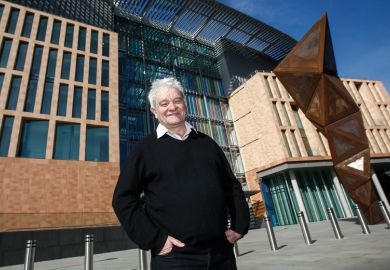After more than a decade of planning that culminated in the construction of a landmark institute with state-of-the-art facilities and an annual budget of £155 million, the expectations for the UK’s newest – and Europe’s largest – biomedical research facility are unmistakably high.
The Francis Crick Institute, which will be two years old next month, has just published the first full-year review of its progress. The £650 million merger of the National Institute for Medical Research and Cancer Research UK’s London Research Institute already holds a wealth of research findings and collaborations – not to mention one group leader with a Nobel prize under his belt. Reflecting on the institute’s progress so far, Sir Paul Nurse, the Crick’s director, said that he was wary of premature praise, however. “We haven’t been around long enough to warrant it,” he told Times Higher Education during a tour of the premises.
And he is right in some ways: the institute’s longest-serving scientists have been in residence for only 18 months; and, although more than 500 papers have been published and discoveries made during that time, the achievements are at least partly, if not completely, attributable to the Crick’s forebears.
It will take years for its scientific output to be measurable by way of spin-offs and patents, but its progress can be felt in other ways. Which is good, Sir Paul noted, because the institute is already undergoing its first external review. The results will not be published for at least two more years, but reviewers have already collected “lots of positive anecdotes”, he said. “Out of 30 people in one consultation, all but one said that it was a great environment to work in.”
As for that one person? “They said it was too big, and they didn’t like it,” said Sir Paul. “You’ll never please everyone. But basically, even those who were reluctant to come here – and there were quite a lot of them – now that they are here, they do see the merit of it.” In this respect, Sir Paul believes that the first part of his strategic vision – the creation of a happy, productive working environment – “has been a success”.
The project still has its critics within the sector as well as outside it. “Sometimes you read about how we steal or absorb all the money, but it’s not true,” Sir Paul said. These critics “are either fearful or jealous or, perhaps, both”, he added. “It’s a complete mistake. The fact is that all the money we have is what we inherited from the core institutes.”
Partner universities to the Crick – UCL, Imperial College London and King’s College London – contributed £40 million each for the construction and set-up of the centre, located in London’s King’s Cross. The rest of the budget came from the Medical Research Council (£270 million), CRUK (£150 million) and the Wellcome Trust (£110 million).
And yet, according to Kieron Flanagan, senior lecturer in science and technology policy at the University of Manchester, the sums involved still present a moral dilemma. “There’s clearly some kind of opportunity cost of such a major investment on the part of the government and its partners,” he told THE. “It’s money that could have been spent elsewhere in the country, for instance, or on other ways of supporting biomedical research.”
In judging the Crick’s successes, he continued, a more interesting question to ask would be what nationwide impact the institute has had so far. Dr Flanagan, who admits to having been highly critical of the project in the past, said that there has clearly been a positive impact in that the Crick has “changed the way we think about science funding in the UK”.
“We’ve since seen the launch of the mini-Crick of the North, the Sir Henry Royce Institute [in Manchester],” he noted, something that arguably would never have been conceived before the creation of the Crick – yet another major London-based research operation – had sparked debate about the geographical concentration of research.
“We’ve also seen the redrawing of the research council system into UK Research and Innovation,” Dr Flanagan said of the changes since the Crick was first proposed. This was a move that some people claim was pushed for “in order to create a funding system more suited to this new era of mega-institutes that could be said to be ‘too big to fail’ and that would realistically always have to have first call on the support of their funders”, he said.
For Sir Paul, the Crick’s vision is simple: to support ambitious research projects “without the boundaries” that a typical university laboratory might face, such as pressure to make science applicable within a short space of time. This is partly what makes working at the institute such an attractive prospect to its staff body – more than a third of whom come from other European Union countries and almost 20 per cent from elsewhere in the world. “They like the vision and the fact that we are very open; people like that it is an inspiring place to work, that they can mix with lots of applicants,” said Sir Paul.
Another strategic priority is to create future science leaders – and this perhaps shows the Crick in its most humble light. Sir Paul wants to train about 100 new postdocs and principal investigators each year, but unlike a traditional university research lab “where they hold on to the researchers for 25 years or so”, group leaders will be given only two contract periods each of six years (a maximum of 12 years in total), meaning that top talent will be turfed out into the wider sector, keeping turnover high and “fresh blood” circulating. This approach will also help the Crick to realise its founding principles of serving as an ambassador for quality, open science across the world.
“We want to trap them, train them and then export them as often as we can to somewhere else in the UK,” Sir Paul explained, “which is the main way we will support the research endeavour. So in other words, we act as a pipeline for talent.” Because the Crick is privileged to receive public funding, this is a “social duty”, he said. “We see ourselves as a conduit for the rest of the country.”
Another priority is to accelerate practical application of science for the UK – and specifically the patenting of new drugs for the NHS. To help with this cause, a translations team sits on the ground floor operating an open-door policy for any researcher wishing to explore an idea or discuss commercialising existing discoveries. It is quite literally “open door” in that they occupy a shared, central workspace at the heart of the building, in keeping with Sir Paul’s ethos of open science, open-plan working – encouraging serendipitous encounters between scientists who might otherwise be shut away in isolation.
Again, Sir Paul said, it is “too soon” to say whether this approach has borne fruit, but looking at translations alone, there are success stories. At least three spin-offs have been cultivated, and a fourth spin-off, in cancer therapy, secured an additional $86 million (£65 million) this month.
Lord Willetts, who oversaw the Crick’s creation as minister for universities and science between 2010 and 2014, is even more ambitious. A marker of the Crick’s success, he told THE, “will be when they’ve cured cancer”. A win for this kind of “grand challenge” would, in his view, “back the whole ‘discovery without boundaries’ ethos”.
“There is an unusually high proportion of British research that is done in a university environment,” continued Lord Willetts, “[but] I do think there is a need to have research establishments that are not all immediately part of the universities.” That the Crick has links with three London universities means that, unlike some research institutes of the past, it will not become “isolated”, Lord Willetts argued.
In the institute’s early stages, Sir Paul expects the Crick to attract further scrutiny from the higher education sector, but he is unconcerned and even welcomes the close attention. “I think once it becomes clear that our objectives are to serve the entire nation with high-quality recruits, once they’ve got the idea that we could train people with great resources, that we can set up conferences and things…then they’ll understand that we are contributing to the great scientific endeavour rather than competing,” he said.
rachael.pells@timeshighereducation.com
At the Crick, scientists mix but are not shaken
In a room 20m underground, two imposing Titan Krios microscopes stand in boxes 4m high.
The instruments, two of the Crick’s proudest assets, can use focused electron beams to reveal complex biological processes to atomic detail – a process known as cryo-electron microscopy, which was recognised in last year’s Nobel Prize in Chemistry.
The structural biologists working down here can easily forget that they are in the middle of one of London’s busiest transport hubs, with frequent trains moving alongside them.
The movements of rolling stock and of busy commuters do not intrude on their work. The microscopes are housed on a base that sits on a cushion of compressed air – a vibration dampener. This is just one example of how the institute's working environment has been future-proofed, with innovations that have won the Crick’s architects praise. Should St Pancras station expand in the future and the ground become even shakier, the researchers will be unaffected.
Four floors up, Georgina Fletcher, a principal researcher at the Crick’s epithelial biology laboratory, is looking for virgin female flies. She shares the space and its 1.5 million fruit fly inhabitants with about 60 researchers working across seven different research groups.
The team provides technical training for researchers, on, say, how to work microscopes and carbon dioxide equipment – which Dr Fletcher has just used to send her flies into a sleepy stupor while she checks them for signs of having mated.
“The leftovers of the larval gut are still present in the adult for a limited time angle,” she explained. This giveaway sign of mating allows Dr Fletcher to select the virgin flies she needs to investigate a mutation affecting cell development.
This kind of knowledge can, in turn, be applied to other areas of genetics because 75 per cent of the genes that cause disease in humans are also found in the humble fruit fly. Which makes it all the more valuable for a researcher such as Dr Fletcher to be able to share her findings – and her flies – with her open-plan lab colleagues.
The Crick in numbers
- More than 80,000 square metres of floor space, including 29,000 square metres of laboratories with 4km of laboratory benching and 22,000 square metres of writing-up space
- 8,400 visitors to the community centre attached to the Crick last year
- 1,544 applications for 45 PhD places starting in September 2018
- 500 journal papers and preprints published last year
- Eleven early career scientists appointed as new group leaders last year
POSTSCRIPT:
Print headline: Two-year check-up shows Crick Institute growing healthily
Register to continue
Why register?
- Registration is free and only takes a moment
- Once registered, you can read 3 articles a month
- Sign up for our newsletter
Subscribe
Or subscribe for unlimited access to:
- Unlimited access to news, views, insights & reviews
- Digital editions
- Digital access to THE’s university and college rankings analysis
Already registered or a current subscriber?







